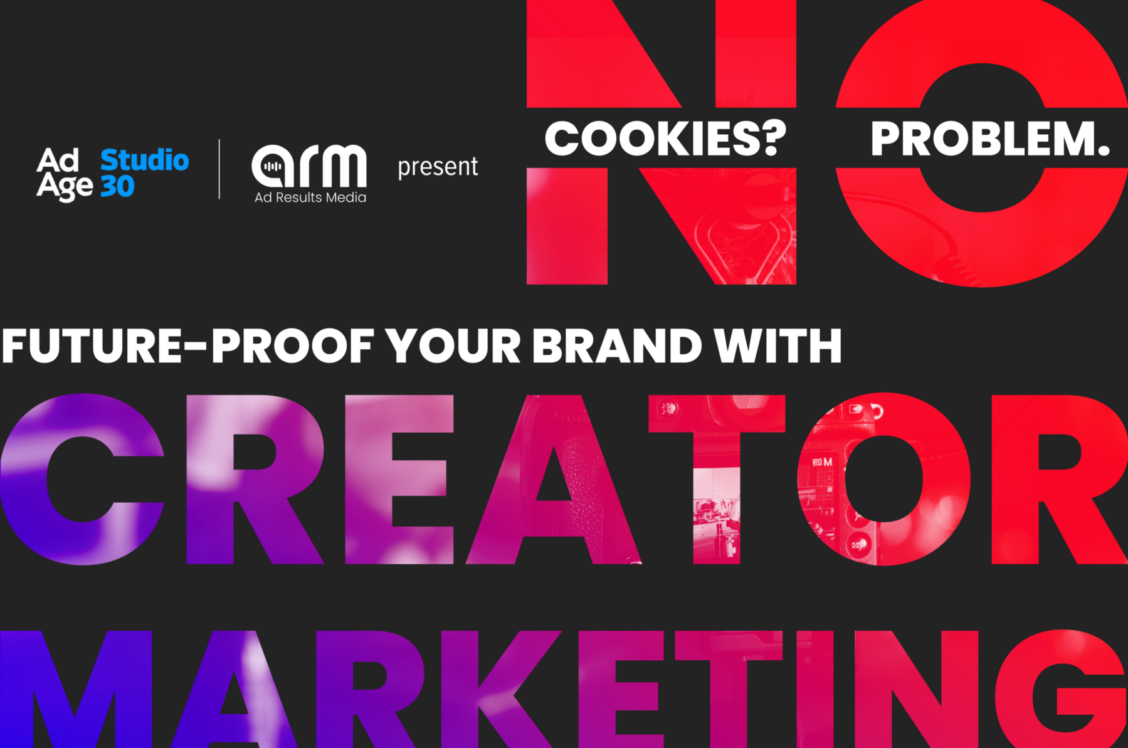No Cookies? No Problem. Futureproof Your Brand With Creator Marketing

GDPR. CCPA. The era of third-party ad targeting is coming to an end. Digital advertising is getting a makeover and cutting out cookies is how they’re trimming the fat.
The marketing industry has been figuring out ways to still target and influence consumers while implementing stringent new privacy standards both in the U.S. and abroad. Browsers like Apple’s Safari, Microsoft’s Edge, and Mozilla’s Firefox have already met these compliance terms, but considering Google’s Chrome accounts for two-thirds of all global internet browsing, digital advertising will truly change forever when Chrome eliminates third-party cookies once and for all in 2024.
Of course, there are also those pesky smartphone trackers, which users are shutting down when given the choice. When Apple gave users the option to opt-in (or out) of advertiser tracking on their industry-leading iPhones in 2021, only 24% of users gave consent. According to a February 3, 2022, report by Markets Insider, Meta, Snap, Twitter, and Pinterest have lost a combined $315 billion in market value since Apple’s privacy update went into effect in April 2021.
So where does this leave marketers who have come to rely on third-party data? How can they efficiently target potential customers without relying on specific demographics or tracking browser history? And how are they supposed to contend with these changes while continuing to navigate a world still struggling with a pandemic, fighting inflation, and seemingly on the brink of a recession?
Creator Marketing: The Smart Alternative to Third-Party Targeting
Fortunately, the preeminent solution exists, one that has ample first-party data and an engaged audience: Creator Marketing.
Creator marketing solves one dilemma right now—reaching a targeted audience at scale in a cost-effective way. High-volume content creators have already attracted and curated an opt-in audience where the relationship is built on trust and credibility. These viewers return multiple times a week to view new content, and they’re highly engaged. They care about the personalities behind their favorite channels, and they want them to succeed.
Aside from a highly engaged audience more apt to convert than any other marketing channel, working with creators also comes with a major cost savings advantage relative to TV and other video mediums. These professional creators are storytellers with a proven method and voice, and they know what will appeal to their audiences. When they’re allowed to create ads on their own terms, even if they happen to film their ad spot on a GoPro camera, the audience still responds positively regardless of the production quality. There is no need for an expensive multi-camera shoot over a multi-week schedule. This combination of original content, the ability to reach new customers without buying up inefficient lists of audience data, and the lack of need for expensive A-list Hollywood talent all translate into a performance marketing channel that is transcendent.
“The performance speaks for itself; creator advertising is recession-proof.” Kurt Kaufer, Chief Growth Officer, Ad Results Media
Check out this Q&A on how YouTube creator partnerships can boost brand authenticity here.
Leave your content to the pros.
You know how people joke about interns running social media accounts? It’s not true. Those are professional account managers with plenty of experience at growing audiences.
It’s also not true that the Creator Economy is just Gen Z or pretty people talking about video games and beauty products on the internet (although many creators are Gen Z and/or pretty people—and gaming and beauty are both extremely popular topics). At the beginning of this year, there were more than 29,000 YouTube channels with more than 1 million subscribers.
According to an Influencer Marketing Hub report compiled this year, some 50 million people worldwide consider themselves creators, and of those, more than 2 million are professionals. And at least half of the professional creators make their money on YouTube.
Some, like 36-year-old Tyler Hoover, actually found a way to turn a passion into a paycheck. A lifelong car fanatic, Hoover owned his own dealership and was using his expertise to write articles for Autotrader.
“I love cars so much it was turning into a problem,” Hoover said, remembering how he realized he was sampling too much of his own supply. “I wanted to keep everything and not sell it.”
After gaining experience doing video and working with advertisers to market his other business franchises, he decided to launch his own brand and YouTube channel, Hoovie’s Garage, in 2016. Hoover might play dumb and call himself an “automotive idiot savant” who makes foolish fixer-upper purchases, but within a few short years, the Kansas hooptie collector created a YouTube following of 1.4 million subscribers.=
Based on his following, Hoover and other creators at his level have authenticated profiles and approved API partners, meaning they have direct access to analytics data. Not only do creators know their audience because they interact with them daily, but they have authenticated data on demographics, impressions, and engagement metrics.
“The creators know their audience and the audience knows the creator,” said Kurt Kaufer, Chief Growth Officer of Ad Results Media. “They have an established relationship where credibility and trust are foundational to the success and vitality of the show and brands can tap into that in a way that drives very positive returns.”
For many of the more popular creators on YouTube, their channels are really just the visual part of their business. Daily Driven Exotics, or DDE, is a team of seven who post professionally edited, 25-minute videos to their channel of 3.1 million subscribers, which averages 45 million views each month. The brand has been around since 2012, and like any good on-screen personalities, they’ve learned how to hype their audience.
“I think the biggest difference between us and some other creators is that [founder] Damon [Fryer] and I are both business-orientated first,” said Dave Coulter, DDE’s chief operating officer, who joined the brand in 2017 after years of facilitating brand deals for clients.
“When you watch the videos, my personality is a lot different,” said Coulter. “Everything’s times 10. Everything’s exciting. I’m yelling, I’m crazy. I’m telling jokes, but behind the scenes, we’re business owners and entrepreneurs. And we’re advertisers who know our goal is to bring in eyeballs.”
Creators have a wealth of first-party audience data.
Cookies and third-party data will soon be a thing of the past, but creators aren’t concerned about this. Their business model relies more on connecting with audiences and actively engaging with them to see which parts of their content do or do not resonate, and then building their base accordingly. They aren’t buying lists of data or auto-subscribing viewers. YouTubers rely on quality content, keyword and metadata algorithms, and real, organic audience engagement.
“Before I joined DDE, I used to create Facebook ad campaigns for brands,” Coulter recalled, “and I remember spending thousands and thousands of dollars just for an ad to appear, trying to get a click.”
The big change he’s seen now is how he doesn’t have to assume to know his target audience—they tell him exactly who they are and what they like. “From a business perspective, what would it cost to get that value elsewhere?” Coulter urged of fellow creators when trying to help them understand their worth.
So how do creators use their own first-party data, and how can marketers use it to their advantage?
Creators use first-party data to better understand the variety of backgrounds and situations their audience is in.
For one, creators use it to better understand the variety of backgrounds and situations their audience are in. Without any data, you may assume that anyone watching DDE or Hoovie’s Garage is a male car enthusiast; this likely isn’t wrong, but it doesn’t present much of a basis for further research or consumer analysis. The channel’s first-party API data, however, would know that one viewer is a professional woman in her mid-30s who recently moved out of New York City—where she had not had a car in more than a decade—and is now trying to find a DIY fix for the leaking radiator in her newly acquired used car. That kind of audience persona intel can open up whole new marketing opportunities when combined with other similar data points.
“First-party data is not self-serving, and it’s more accurate because there is far less modeling or manipulation of it,” said Gretchen Smith, VP of media and creative at Ad Results Media. “The validity and accuracy help brands unveil new potential audiences and marketing strategies that they may not have considered before.”
And Smith would know—watching those Hoovie’s Garage videos helped her, a former city slicker, find the proper floormats for her used car.
Make every dollar impression and engagement count with creator marketing
The industry has been quietly stressing about a looming global recession coming on the heels of the pandemic and supply chain downturns. And while most marketing leaders do not anticipate any sudden and extreme reduction in overall spending that rivals the pandemic-related cuts of 2020, they aren’t exactly bullish either.
Because of that, every dollar matters. Every ad spend needs to generate positive metrics, and channel allocations will become even more deliberate and heavily scrutinized. That is where Ad Results Media believes creator marketing can help ease some of the pain.
Creator marketing delivers high-quality branded content to a receptive and targeted audience—there are very few, if any, “wasted” impressions or passive engagements, which is hard to say of linear TV or print media ads, said Kaufer.
Kaufer has extensive experience in performance marketing, both building and overseeing digital marketing efforts for the e-commerce giant Provide Commerce and the sock brand Stance before co-founding the performance marketing agency Brown Bear Digital in 2013.
“Creators were my silver bullet, even back in the early 2010s,” Kaufer said. “At first, podcasters were the new growth channel that entered the mix only after other digital channels had reached points of diminishing returns. But as the medium matured, and we learned how to maximize the value of the channel, it became a primary channel that outperformed all others. The same can be said for video creators.”
As an example, Ad Results Media was recently able to scale YouTube media spend by more than 8x for Stamps.com and 14x for ShipStation.com in over a year while meeting their cost-per-action (CPA) goals.
Tool Tips
- When searching for a creator to align your brand with, remember that getting your ad in front of the right eyes is more important than getting it in front of a magnitude of eyes.
- “When you’re buying ad space on a YouTube channel, you are buying the impressions, but that’s just a part of it,” says Coulter. “What you’re really buying is the trust that person’s built with the audience over many, many, many years. That’s the real value.”
- Not only that, but viewers know that supporting brands who support their favorite creators is a solid bet. Creators can’t afford to jeopardize the trust they’ve built up, so audiences know they’ll vet the sponsors they align with.
- “When I say, ‘Support my generous sponsor and check out their brand,’ that’s a pretty strong call to action,” said Tyler Hoover of Hoovie’s Garage. “And when you have a devoted fan base who wants to see you do more dumb things on your channel, they’re much more inclined to go buy something.”
“When I create an ad, it integrates very easily in the video,” said Hoover, “unlike in television or traditional ads where, when the viewer sees a different face, they’ll skip because it’s not part of the show.”
Qualitative benefits of creator marketing
- Seamless ads: When the creator includes an ad in their video, there’s no option for the viewer to press “skip ad”—and most don’t skip ahead anyway.
- Reliable tracking: Whatever call-to-action a brand wants to use—a QR code, link, etc.—the creator can make that obvious and available. Such codes or clicks are dependable metrics.
Creator marketing might just be coming out of its infancy stage, but there is so much growth potential in this field. “I think the future will be more of those big brands coming over and spending their money on creator marketing,” Hoover predicted, “especially as the next generation starts coming up in these marketing and PR departments.” Essentially, the next-generation digital natives—the YouTube and social media experts who instinctively know how to sell—will expand on this growth in the future.
Other benefits
- Another benefit of close collaboration with creators is that they listen and interact with their audience in an authentic way.
- Because of this, creators across the board say that they’ll only promote products that they really believe in or want to back because the trust their viewers place in them is critically important.
- Honest delivery
- “We have to make sure that the product delivers what they say because if you push one product that wasn’t an honest item, that comes back on the creator, not the brand,” said Dave Coulter of DDE.
- Emphasis on accountability can work for both the brand and creator if both parties are willing to take constructive criticism.
- “At Daily Driven Exotics, we’ll even go as far as forwarding any customer comments or complaints to the brand and have ongoing conversations to make sure the matter is resolved,” Coulter said. “Once we find those brands that are really dedicated to quality of service and building the same trust we try to build, those are the brands we partner with for the long term.”
Creators make excellent collaborators. They may even teach us a few things.
Ad Results Media has been working with personality-driven media since its inception in 1998 and has run countless campaigns with radio DJs, podcast hosts, YouTubers, and social content creators. But one thing it has seen clients realize over and over again is that they can’t assume they know exactly where their potential audience is or isn’t.
“As much intuition as we may think we have regarding the best show and audience fit for a client, our experience—and the data—has proven that the obvious is not so obvious,” said Kaufer. “We always encourage clients to approach creator channels like YouTube and podcasts with a test-and-learn mentality. It’s almost guaranteed that we’ll discover a show whose performance surprises us. Brands that focus on business solutions don’t always have to partner with business-related shows to have success.”
In fact, through Ad Results media, some of their clients in these categories actually found more success on automotive channels than in the finance category. But this shouldn’t be surprising, Coulter said. Viewers who watch “car channels” are also business owners, managers, and workers of all stripes.
A good example is Daily Driven Exotics. The team buys, races, deconstructs, and lavishes love on the pricey, exotic cars they feature, but according to Coulter, they hardly ever work with automotive brands.“Ironically, DDE is more of a lifestyle brand,” Coulter said. “First and foremost, it’s entertainment. We built our brand so anybody can watch [our videos]. Our audience is mainly male—that just came with the territory—but we’ve always looked at how can we make our content inclusive for everyone.”
“It’s important to understand that humans, in general, are multifaceted, multidimensional,” Coulter emphasized. “People do watch DDE because they like cars, but they could like to watch it for the dynamic of the characters, the friendship, the storyline. They could watch it for a multitude of reasons.”
One industry that he’s constantly surprised by: high-end jewelry. “We’ve always been puzzled over why jewelry brands on Valentine’s Day are only marketing to female channels and not on male channels?” Coulter said. “Because I can tell you the DDE guys spend a lot of money on the women in their lives, and we’re willing to sell that from a genuine perspective.”
Ad Results Media has successfully paired creators with brands in divisions ranging from watches and accessories to consumer goods like grooming products to video games. As Coulter put it succinctly: “I like cars, but guess what? I also have to wear deodorant.”
—
Link to original Ad Age report.
Be part of the story and follow along on social @adresultsmedia or contact us here.


